The new mechanism of bone cancer pain is waiting for your research. Amy Jet helps recommend research tools.
As the saying goes, toothache is not a disease, it hurts to kill people. Medically defined pain is a complex physiological and psychological activity and one of the most common symptoms in the clinic. It includes the painful sensation caused by noxious stimuli on the body, and the painful response of the body to noxious stimuli (somatic motility and/or visceral vegetative reactions, often accompanied by strong emotional color). Pain can be used as a warning to the body's injury, causing a series of defensive protective responses. On the other hand, pain has its limitations as an alarm (such as when there is pain in cancer).
In February of this year, Brain, Behavior, and Immunity published an article entitled Professor STAT1 as a downstream mediator of ERK signaling contributes to bone cancer pain by regulating MHC II expression in spinal microglia. The article describes the related mechanisms of bone cancer pain.
Many malignant tumors can cause severe cancer-induced bone pain, and the mechanism of bone cancer pain is currently not well understood, which makes the treatment of bone cancer pain (BCP) not ideal. Many studies on the effects of spinal dorsal glial cells suggest that MHC II may be a key molecule in chronic neuropathic pain and autoimmune diseases, so the authors believe that regulation of MHC II expression in spinal microglia to inhibit adaptation Poor neuroimmune response may be a potential treatment strategy for pain relief. Therefore, the authors studied the role of MHC II in BCP.
In the author's 2015 study, the ERK signaling pathway is involved in the pathogenesis of BCP, and studies have shown that activation of the ERK signaling pathway enhances STAT1 phosphorylation. Interestingly, the STAT1 signaling pathway is a key regulator of MHC II expression by regulating the expression of class II transactivator (CIITA). Because the authors specifically analyzed the relationship between ERK and STAT1 in signaling pathways that regulate MHC II expression.
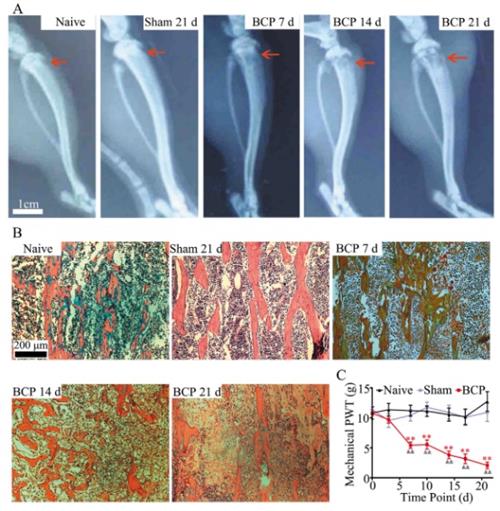
The author conducts research through the rat BCP model and begins to explain the mechanism of BCP from many aspects. Radiological studies of the BCP model showed signs of time-dependent osteolytic destruction in the proximal bone of the ipsilateral tibia (red arrow), and some cancer cells also migrated from the tibial cavity on day 21 and damaged peripheral soft tissue. . HE stained sections showed that normal bone marrow cells were replaced by inoculated Walker 256 cancer cells, and healthy bone structures disappeared from day 14. The Paw-Withdrawal Threshold (PWT) test results as a nociceptive threshold showed that the PWT of the BCP experimental group continued to deteriorate. These experimental results indicate that vaccination of Walker 256 cancer cells induces osteolysis of the tibia and mechanical allodynia.
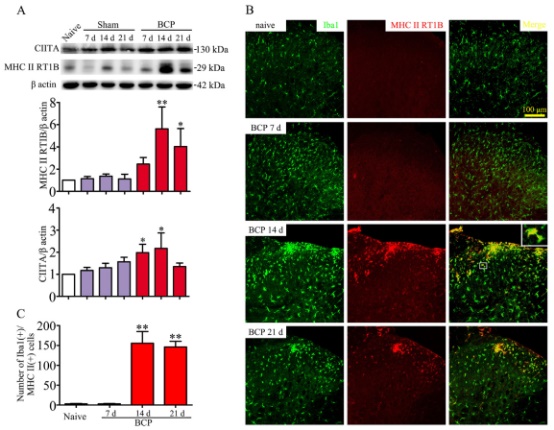
Western Blot results showed that the expression of CIITA and MHC II RT1B was significantly induced after vaccination with Walker 256 cancer cells, and the maximum value was reached on day 14. Double immunofluorescence staining showed that MHC II RT1B (red) was co-expressed with Iba1 (green) positive cells in the superficial spinal dorsal horn of BCP rats 14 days after inoculation with Walker 256 cancer cells. The number of Iba1 and MHC II RT1B double positive cells was counted using a laminate and found to increase sharply 14 days after BCP until the end of the observation.
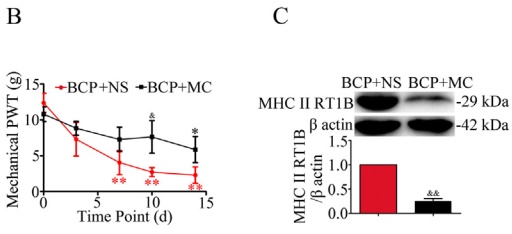
PWT and other tests on BCP model mice showed that the mechanical contraction threshold (PWT) of BCP rats decreased from baseline 12.38±1.34g to 4.05±1.68g on the 7th day after surgery, and continued to the 14th day. Compared with normal saline (NS), minocycline (MC) can effectively improve the development of mechanical allodynia and inhibit the upregulation of MHC II RT1B. This suggests that MHC II mediates mechanical abnormal pain in BCP.
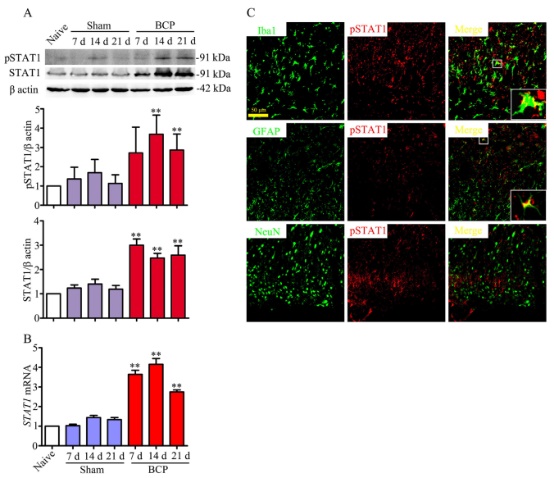
In addition, the mRNA and protein levels of STAT1 were significantly up-regulated in BCP rats, but the protein levels of total STAT1 and phosphorylated STAT1 were significantly different. From the confocal results, pSTAT1 ser727 was co-localized with Ibal and GFAP and was not co-localized with NeuN.
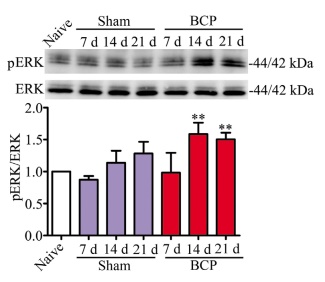
Similarly, phosphorylation of ERK was significantly enhanced in BCP rats. Further studies revealed that ERK signaling regulates phosphorylation of STAT1 and that pSTAT1 regulates MHC II expression in the spinal cord under BCP conditions.
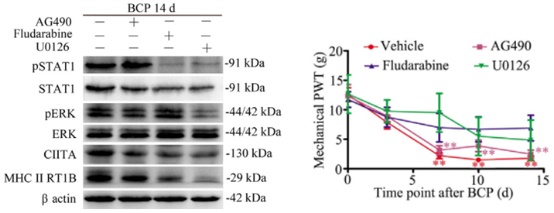
Western Blot results showed that AG490 significantly increased pSTAT1 ser727 levels in the spinal cord of BCP rats, while Fludarabine and U0126 significantly inhibited pSTAT1 ser727, CIITA and MHC II RT1B levels. In addition, U0126 also significantly inhibited pERK levels.
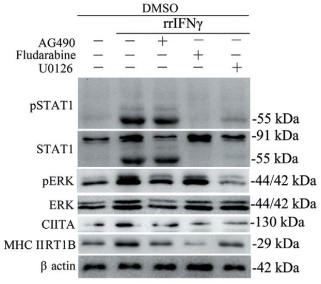
However, Western Blot results after addition of recombinant rat IFNγ showed that the effect of AG490 on pSTAT1 ser727 was inhibited, while Fludarabine and U0126 still significantly inhibited pSTAT1 ser727, CIITA and MHC II RT1B levels. In addition, U0126 also significantly inhibited STAT1 and pERK levels. These evidences suggest that ERK signaling regulates phosphorylation of STAT1 in a BCP rat model, and that pSTAT1 regulates MHC II expression in the spinal cord under BCP conditions.
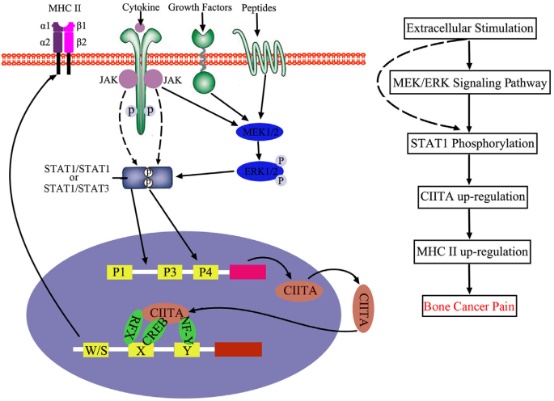
Therefore, the authors proposed the regulation mechanism of MHC II in BCP - extracellular stimulation activates ERK signaling pathway leading to phosphorylation of STAT1, which promotes up-regulation of CIITA, further up-regulating MHC II RT1B levels, and ultimately leading to bone cancer pain.
The mechanism of bone cancer pain is to be further studied by you. Most of the pains studied at present are caused by abnormal ion channels or cancer. Of course, there are phenomena in the cancer that cause ion channel abnormalities. A more in-depth study of the mechanisms of pain production will help enrich treatments and improve the quality of life and physical function of patients. Good research tools are essential for the study of pain mechanisms. As mentioned in the article, Jackson's fluorescent secondary antibody, antibodies and inhibitors required for ERK/STAT1 signaling pathway research, etc., Ai Meijie has been introduced many times in the previous brand product introduction, Jackson, cayman, AAT is a world-renowned brand with complete products and guaranteed quality. The so-called wine is not afraid of the deep alley, and will not be described here. Amy Jie today wants to recommend to you the pain-related research antibodies provided by partner Alomone.
Alomone is a globally renowned supplier of ion channel related products in Israel. Their antibodies are rigorously designed to ensure maximum immunoaffinity and no cross-linking reactivity. Each antibody also provides a free antigen as a quality control. At present, Alomone has 179 pain-related products including TRPV2, Cannabinoid Receptor, Ca/Na/K ion channel and Nicotinic Acetylcholine Receptor, and more products are still under development. At the same time, Amy Jie also recommended a neuron tracer. This tracer is produced by Amy Jie's new partner, the famous biomarker testing product supplier Vectorlabs. Amy Jie is committed to providing the most comprehensive and best research tools for the majority of research partners, and learn more about the products. Welcome to contact us.
| product name | Item number | Details |
| Anti-TRPV1 | ALO-ACC-030-50 | Details |
| Anti-Cannabinoid Receptor 1 (extracellular) | ALO-ACR-001-50 | Details |
| Anti-CaV3.1 | ALO-ACC-021-50 | Details |
| Anti-KV4.2 | ALO-AGP-038-50 | Details |
| Anti-NaV1.1 | ALO-AGP-043-50 | Details |
| Anti-Nicotinic Acetylcholine Receptor alpha6 (extracellular) | ALO-ANC-006-50 | Details |
| NEUROBIOTIN Tracer | SP-1120 | Details |

PDO/PCL Threads,Pdo Threads,Pcl Threads,Pdo Thread Lift
Qingdao Beautiful Skin Biotechnology Co., Ltd , https://www.hafilleresthetic.com